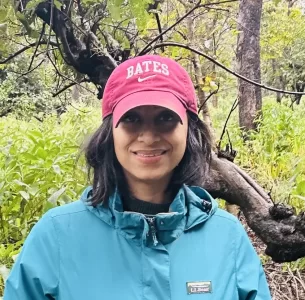Shreya Arora

Shreya Arora
Assistant Professor of Earth and Climate Science
Associations
Earth and Climate Sciences
Asian Studies
About
Shreya Arora (PhD, Indian Institute of Technology Kanpur; Postdoctoral Fellow, Geological Survey of Japan) is a paleoseismologist who investigates past earthquakes to assess future seismic hazards. Her research focuses on reconstructing past earthquake chronologies and magnitudes in the Himalayas and the Andes of Argentina. Her recent publication, “Earthquake rupture variability along the central seismic gap segment (78°–82°E) of the Himalayan Frontal Thrust, Western and Central Himalaya”, in the high-impact, peer-reviewed journal Nature Scientific Reports, presents evidence of three major earthquakes since the 14th century. These events include rupture lengths of up to 490 km and estimated magnitudes as high as Mw 8.7. Her findings highlight the critical role of structural asperities in governing rupture behavior along one of the world’s most seismically active plate boundaries.
She deploys lidar drones for high-resolution mapping and integrates remote sensing, seismic analysis, borehole stratigraphy, trench investigations, and Quaternary dating techniques to quantify fault slip rates and earthquake recurrence intervals. She holds a leadership position as the 2nd Vice Chair at the Geological Society of America (GSA), Geology and Society Division, and the Project Leader for CHAMP (Cascading Hazards and Mitigation Strategy), TERPRO, and INQUA from 2023 to 2027.
Her related work includes
2025
Shreya Arora, Natalie Meenan, Eshaan Srivastava, Drew Cochran, Alana Williams, Mitthu Dhali, Monika Kumaiya, Ramon Arrowsmith, Javed N Malik, Hisao Kondo Earthquake rupture variability along the Central Seismic Gap Segment (78°-82°E) of the Himalayan Frontal Thrust, western and central Himalaya, Scientific Reports
2024
Malik, J.N., Srivastava, E., Gadhavi, M.S. Franz Livio, Nayan Sharma, Shreya Arora, Nicolo Parrino, Pierfrancesco Burrato, Attilio S.(2024) Holocene surface-rupturing paleo-earthquakes along the Kachchh Mainland Fault: shaping the seismic landscape of Kachchh, Western India. Sci Rep 14, 11612 (2024). https://doi.org/10.1038/s41598-024-62086-z
2023
Malik, J.N., Arora, S., Gadhavi, M.S., Singh, G., Johnson, F.C., M, Thakur (2023). Geological evidence of paleo-earthquakes on a transverse right-lateral strike-slip fault along the NW Himalayan front: Implications towards fault segmentation and strain ” Journal of Asian Earth Sciences 244: 105518. https://doi.org/10.1016/j.jseaes.2022.105518
Malik, J.N., Mohanty, A., Swaroop, S.S., Gadhavi, M.S., Dhali M, Arora, S., Naik, S. (2023) Signatures of 16th and 19th century paleo-earthquakes along the Himalayan Frontal Thrust (HFT): Implications to Seismic Hazard Assessment. Quaternary International, Volume 656, Pages 37-47, May, 2023. (https://doi.org/10.1016/j.quaint.2023.02.001).
2021
Arora, S., Kondo, H., Kurosawa, H., Koshika, K., (2021). Estimation of the slip rate along the unruptured fault segment of Mw 7.2 1896 Rikuu earthquake, northeast Japan. Tectonics, 40 e2020TC006434 https://doi.org/10.1029/2020TC006434
2019
Arora, , Malik, J.N., Sahoo, S., (2019). Paleoseismic evidence of a major earthquake event(s) along the Hinterland faults: Pinjore Garden Fault (PGF) and Jhajra Fault, Northwest Himalaya, India. Tectonophysics 757, 108-122. https://doi.org/10.1016/j.tecto.2019.01.001
Malik, N., Johnson, F.C., Khan, A., Sahoo, S., Irshad, R., Paul, D., Arora, S., Baghel, P.K., Chopra,(2019). Tsunami records of the last 8000 years in the Andaman Island, India from mega and large earthquakes:Insights on recurrence interval. Scientific Reports 9, 18463 (2019) https://doi.org/10.1038/s41598-019-54750-6
2017
Arora, S., Malik, J.N., (2017). Overestimation of the earthquake hazard along the Himalaya: constraints in bracketing of medieval earthquakes from paleoseismic studies. Geosci Lett 4:19. https://doi.org/10.1186/s40562-017-0083-6
For more information, you can visit her Teaching page.